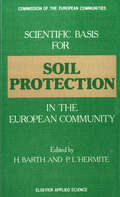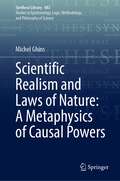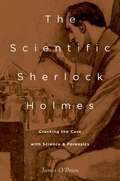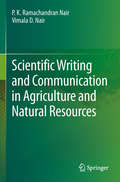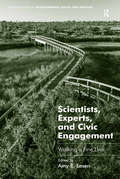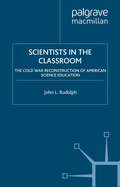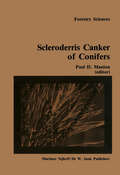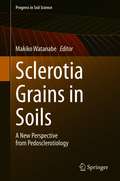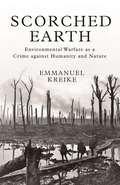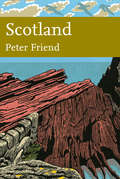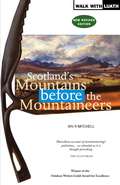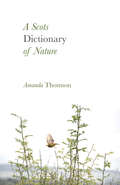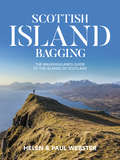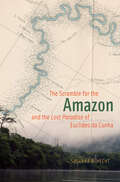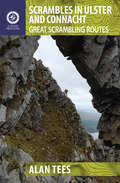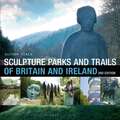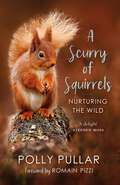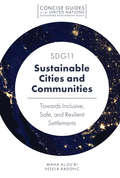- Table View
- List View
Scientific Basis for Soil Protection in the European Community
by H. Barth P. L'HermitePH. BOURDEAU Directorate-General Science. Research and Development. Commission of the European Communities. Brussels. Belgium We are living on a unique planet, the only one in the solar system where life exists. The very existence of life has modified the physical and chemical environment of the earth, its atmosphere and oceans, in a way that makes life sustainable. This system with its complex cybernetic mechanisms has been named GAIA by Lovelock. Man has always interfered with it on a more or less limited scale. This interference is now reaching global proportions such as climate modifications resulting from CO and trace gas 2 accumulation in the atmosphere or the destruction of stratospheric ozone, not to speak of global radioactive contamination. GAIA will probably prevail as a living system but it probably does not give much importance to man's survival as such, and it is man that has to take care of his own survival. In the ecosystem of Planet Earth, soils are the thin interface between lithosphere and atmosphere which constitutes the essential substrate for the terrestrial biosphere, the productivity of which far exceeds that of the oceans, even though the latter cover a much larger area than the continents. Soils themselves are complex systems. They develop through weathering of minerals, are colonised by living organisms which in turn modify their substrate making it suitable for other organisms. This induces a primary ecological succession which eventually reaches a climax, in equilibrium between climate, soil and the biological communities.
Scientific Realism and Laws of Nature: A Metaphysics of Causal Powers (Synthese Library #483)
by Michel GhinsThis book addresses central issues in the philosophy and metaphysics of science, namely the nature of scientific theories, their partial truth, and the necessity of scientific laws within a moderate realist and empiricist perspective. Accordingly, good arguments in favour of the existence of unobservable entities postulated by our best theories, such as electrons, must be inductively grounded on perceptual experience and not their explanatory power as most defenders of scientific realism claim. Similarly, belief in the reality of dispositions such as causal powers which ground the natural necessity of scientific laws must be based on experience. Hence, this book offers a synthetic presentation of an original metaphysics of science, namely a metaphysics of properties, both categorical and dispositional, while at the same time opposing strong versions of necessitarism according to which laws are true in all possible worlds.The main theses and arguments are clearly presentedin a non-technical way. Thus, on top of being of interest to the specialists of the topics discussed, it is also useful as a textbook in courses for third year and more advanced university students.
The Scientific Sherlock Holmes: Cracking the Case with Science and Forensics
by James O'BrienOne of the most popular and widely known characters in all of fiction, Sherlock Holmes has an enduring appeal based largely on his uncanny ability to make the most remarkable deductions from the most mundane facts. The very first words that Sherlock Holmes ever says to Dr. Watson are, "How are you? You have been in Afghanistan, I perceive." Watson responds, "How on earth did you know that?" And so a crime-solving legend is born. In The Scientific Sherlock Holmes, James O'Brien provides an in-depth look at Holmes's use of science in his investigations. Indeed, one reason for Holmes's appeal is his frequent use of the scientific method and the vast scientific knowledge which he drew upon to solve mysteries. For instance, in heart of the book, the author reveals that Holmes was a pioneer of forensic science, making use of fingerprinting well before Scotland Yard itself had adopted the method. One of the more appealing aspects of the book is how the author includes real-world background on topics such as handwriting analysis, describing how it was used to capture the New York Zodiac killer and to clinch the case against the Lindbergh baby kidnapper. Sherlock Holmes was knowledgeable about several sciences, most notably chemistry. Therefore the book takes a close look at Holmes the chemist and discusses, for example, chemical poisons such as carbon monoxide, chloroform, and Prussic acid (the historical name for hydrogen cyanide). The author also debunks Isaac Asimov's famous assertion that Holmes was a blundering chemist. In addition, the book discusses mathematics, physics, biology, astronomy, meteorology, and geology, always in the context of Holmes's exploits. Sherlock Holmes continues to fascinate millions of readers and movie goers alike. The Scientific Sherlock Holmes is a must-read for the legion of fans of this most beloved of all fictional detectives. The paperback version will continue to interest two primary groups: the community of avid Holmes fans who meet regularly to celebrate and discuss the stories, and the scientific community. What scientist would not wish to be "the most perfect reasoning and observing machine that the world has seen"? Sherlock Holmes, Watson assures us, was precisely that. Scientists admire Holmes's devotion to fact, his intellectual brilliance, and the way he separates emotion from his work, and will be especially attracted by a book that explicitly discusses Holmes from a scientific perspective.
The Scientific Sherlock Holmes: Cracking the Case with Science and Forensics
by James O'BrienOne of the most popular and widely known characters in all of fiction, Sherlock Holmes has an enduring appeal based largely on his uncanny ability to make the most remarkable deductions from the most mundane facts. The very first words that Sherlock Holmes ever says to Dr. Watson are, "How are you? You have been in Afghanistan, I perceive." Watson responds, "How on earth did you know that?" And so a crime-solving legend is born. In The Scientific Sherlock Holmes, James O'Brien provides an in-depth look at Holmes's use of science in his investigations. Indeed, one reason for Holmes's appeal is his frequent use of the scientific method and the vast scientific knowledge which he drew upon to solve mysteries. For instance, in heart of the book, the author reveals that Holmes was a pioneer of forensic science, making use of fingerprinting well before Scotland Yard itself had adopted the method. One of the more appealing aspects of the book is how the author includes real-world background on topics such as handwriting analysis, describing how it was used to capture the New York Zodiac killer and to clinch the case against the Lindbergh baby kidnapper. Sherlock Holmes was knowledgeable about several sciences, most notably chemistry. Therefore the book takes a close look at Holmes the chemist and discusses, for example, chemical poisons such as carbon monoxide, chloroform, and Prussic acid (the historical name for hydrogen cyanide). The author also debunks Isaac Asimov's famous assertion that Holmes was a blundering chemist. In addition, the book discusses mathematics, physics, biology, astronomy, meteorology, and geology, always in the context of Holmes's exploits. Sherlock Holmes continues to fascinate millions of readers and movie goers alike. The Scientific Sherlock Holmes is a must-read for the legion of fans of this most beloved of all fictional detectives. The paperback version will continue to interest two primary groups: the community of avid Holmes fans who meet regularly to celebrate and discuss the stories, and the scientific community. What scientist would not wish to be "the most perfect reasoning and observing machine that the world has seen"? Sherlock Holmes, Watson assures us, was precisely that. Scientists admire Holmes's devotion to fact, his intellectual brilliance, and the way he separates emotion from his work, and will be especially attracted by a book that explicitly discusses Holmes from a scientific perspective.
Scientific Writing and Communication in Agriculture and Natural Resources
by P.K. Ramachandran Nair Vimala D. NairThe purpose of this book is to help early career professionals in agriculture and natural resources write their research papers for high-quality journals and present their results properly at professional meetings. Different fields have different conventions for writing style such that the authors of the book have found it difficult to recommend to young scientists in these fields a specific book or source material out of the several that are available as the “go to” guide. Writing a scientific paper is a tedious task even to experienced writers; but it is particularly so for the early career professionals such as students, trainees, scientists and scholars in agriculture and natural resources; the challenge is even more when their first language of communication is not English. This book is targeted mainly to that group.
Scientists, Experts, and Civic Engagement: Walking a Fine Line (Routledge Studies in Environmental Policy and Practice)
by Amy E. LesenHow do scientists, scholars, and other experts engage with the general public and with the communities affected by their work or residing in their sites of study? Where are the fine lines between public scholarship, civic engagement, and activism? Must academics 'give back' once they collect data and publish results? In this volume, authors from a wide range of disciplines examine these relationships to assess how they can be fruitful or challenging. Describing the methodological and ethical issues that experts must consider when carrying out public scholarship, this book includes a checklist for critical factors of success in engagement and an examination of the role of digital social media in science communication. Illustrated by a range of case studies addressing environmental issues (climate change, resource use, post-disaster policy) and education, it offers an investigation into the levels and ways in which scholars can engage, and how and whether academics and experts who engage in community work and public scholarship are acknowledged and rewarded for doing so by their institutions. Also bringing into the debate the perspective of citizens who have collaborated with academics, the book offers an exploration of the democratizing potential of participatory action research.
Scientists, Experts, and Civic Engagement: Walking a Fine Line (Routledge Studies in Environmental Policy and Practice)
by Amy E. LesenHow do scientists, scholars, and other experts engage with the general public and with the communities affected by their work or residing in their sites of study? Where are the fine lines between public scholarship, civic engagement, and activism? Must academics 'give back' once they collect data and publish results? In this volume, authors from a wide range of disciplines examine these relationships to assess how they can be fruitful or challenging. Describing the methodological and ethical issues that experts must consider when carrying out public scholarship, this book includes a checklist for critical factors of success in engagement and an examination of the role of digital social media in science communication. Illustrated by a range of case studies addressing environmental issues (climate change, resource use, post-disaster policy) and education, it offers an investigation into the levels and ways in which scholars can engage, and how and whether academics and experts who engage in community work and public scholarship are acknowledged and rewarded for doing so by their institutions. Also bringing into the debate the perspective of citizens who have collaborated with academics, the book offers an exploration of the democratizing potential of participatory action research.
Scientists in the Classroom: The Cold War Reconstruction of American Science Education
by J. RudolphDuring the 1950s, leading American scientists embarked on an unprecedented project to remake high school science education. Dissatisfaction with the 'soft' school curriculum of the time advocated by the professional education establishment, and concern over the growing technological sophistication of the Soviet Union, led government officials to encourage a handful of elite research scientists, fresh from their World War II successes, to revitalize the nations' science curricula. In Scientists in the Classroom , John L. Rudolph argues that the Cold War environment, long neglected in the history of education literature, is crucial to understanding both the reasons for the public acceptance of scientific authority in the field of education and the nature of the curriculum materials that were eventually produced. Drawing on a wealth of previously untapped resources from government and university archives, Rudolph focuses on the National Science Foundation-supported curriculum projects initiated in 1956. What the historical record reveals, according to Rudolph, is that these materials were designed not just to improve American science education, but to advance the professional interest of the American scientific community in the postwar period as well.
Scleroderris canker of conifers: Proceedings of an international symposium on scleroderris canker of conifers, held in Syracuse, USA, June 21–24, 1983 (Forestry Sciences #13)
by P. D. ManionThe "International Symposium on Scleroderris Canker of Conifers" held June 21-24, 1983 in Syracuse, New York was the result of mutual interest expressed by the USDA Forest Service, the Canadian Forestry Service, and the State Uni versity of New York College of Environmental Science and Forestry (SUNY ESF). The Symposium was an official function of the working party canker diseases (Scleroderris), Subject group S.2.06.02 Division II IUFRO. We wish to express our thanks to the USDA Forest Service, Research and the Canadian Forestry Service for financial support of the program, and SUNY ESF for hosting the Symposium. A major research program was launched in 1977 to study the biology of the European strain as found in North America. Support for this research resulted from spec i a 1 fund ing by the Congress of the United States to the USDA Forest Service, North Central Forest Experiment Station. Most of these funds were released as cooperative research grants to universities in the Lake States and the northeast. Many of the research papers delivered at this Symposium are the direct result of these research grants. While the Symposium deliberately emphasized the North American experience 'with Gremmeniella abietina in order to provide a focus for the meeting, we were anxious that this Symposium would also include studies from other countries.
Sclerotia Grains in Soils: A New Perspective from Pedosclerotiology (Progress in Soil Science)
by Makiko WatanabeThis book introduces what sclerotia grains are, and where and how they exist in soils, by compiling the results obtained from the studies on fungal sclerotia formed by Cenococcum geophilum (Cg) and related species, the visible black small grains persistent for a few thousand to ten thousands of years in forest soils and sediments. The chapters contain the results and discussions on the ecological distribution and regulating factors, characteristics, and function of Cg sclerotia grains, carried out by researchers from soil geography, soil science, soil microbiology, physiology, forestry, analytical chemistry, environmental chemistry, material science, and related disciplines. The anatomy of sclerotia grains in soil was realized in terms of interdisciplinary joint researches, which resulted in deepening understanding of the ecological function of the mesoscale organic component in soils. This book covers the natural history of sclerotia in soils, pedo-sclerotiology.
Scorched Earth: Environmental Warfare as a Crime against Humanity and Nature (Human Rights and Crimes against Humanity #38)
by Emmanuel KreikeA global history of environmental warfare and the case for why it should be a crimeThe environmental infrastructure that sustains human societies has been a target and instrument of war for centuries, resulting in famine and disease, displaced populations, and the devastation of people’s livelihoods and ways of life. Scorched Earth traces the history of scorched earth, military inundations, and armies living off the land from the sixteenth to the twentieth century, arguing that the resulting deliberate destruction of the environment—"environcide"—constitutes total war and is a crime against humanity and nature.In this sweeping global history, Emmanuel Kreike shows how religious war in Europe transformed Holland into a desolate swamp where hunger and the black death ruled. He describes how Spanish conquistadores exploited the irrigation works and expansive agricultural terraces of the Aztecs and Incas, triggering a humanitarian crisis of catastrophic proportions. Kreike demonstrates how environmental warfare has continued unabated into the modern era. His panoramic narrative takes readers from the Thirty Years' War to the wars of France's Sun King, and from the Dutch colonial wars in North America and Indonesia to the early twentieth century colonial conquest of southwestern Africa.Shedding light on the premodern origins and the lasting consequences of total war, Scorched Earth explains why ecocide and genocide are not separate phenomena, and why international law must recognize environmental warfare as a violation of human rights.
Scotland (Collins New Naturalist Library #119)
by Peter FriendHarnessing recent developments in computer technology, the latest New Naturalist volume uses the most up-to-date and accurate maps, diagrams and photographs to analyse the diverse landscapes of Scotland.
Scotland's Mountains Before the Mountaineers
by Ian R MitchellWinner of the Outdoor Writers Guild Award for Excellence In this new book on pre-mountaineering ascents and near ascents in the Highlands, we have at last a work which does justice to those who lived and worked, travelled and fought in the Highlands before Walter Scott. PROF. BRUCE LENMAN Marvelous account of mountaineering's prehistory... as colourful as it is thought provoking - THE SCOTSMAN This work tells the story of explorations and ascents in the Scottish Highlands in the days before mountaineering became a popular sport - when Jacobites, bandits, poachers and illicit distillers traditionally used the mountains as sanctuary.
A Scots Dictionary of Nature
by Amanda ThomsonScotland is a nation of dramatic weather and breathtaking landscapes – of nature resplendent. And, over the centuries, the people who have lived, explored and thrived in this country have developed a rich language to describe their surroundings: a uniquely Scottish lexicon shaped by the very environment itself. A Scots Dictionary of Nature brings together – for the first time – the deeply expressive vocabulary customarily used to describe land, wood, weather, birds, water and walking in Scotland. Artist Amanda Thomson collates and celebrates these traditional Scots words, which reveal ways of seeing and being in the world that are in danger of disappearing forever. What emerges is a vivid evocation of the nature and people of Scotland, past and present; of lives lived between the mountains and the sky.
Scots Pine tree (Large Print)
by Rnib BookshareIn this image of a Scots pine tree, the trunk stems from the bottom centre of the page and the leafy branches are in the middle of the page. There is a locator dot shown, which will be at the top left of the page when the image is the right way up. There is a picture of some Scots pine needles in the top left and a picture of a Scots pine cone in the top right of the page. The needle leaf stem is to the top right of the needles themselves. For scale there is a 'stick man' representing the height of an adult person in the bottom right of the page. There are only three true native coniferous trees in Britain and the Scots pine is one of them. It is a very distinct tree with its red bark and rugged foliage. It lives for 150 years and sometimes can survive for 300 years. Its wood is rot resistant and therefore useful for outdoor purposes. The seeds are held in the pine cone.
Scots Pine tree (UEB Contracted)
by Rnib BookshareIn this image of a Scots pine tree, the trunk stems from the bottom centre of the page and the leafy branches are in the middle of the page. There is a locator dot shown, which will be at the top left of the page when the image is the right way up. There is a picture of some Scots pine needles in the top left and a picture of a Scots pine cone in the top right of the page. The needle leaf stem is to the top right of the needles themselves. For scale there is a 'stick man' representing the height of an adult person in the bottom right of the page. There are only three true native coniferous trees in Britain and the Scots pine is one of them. It is a very distinct tree with its red bark and rugged foliage. It lives for 150 years and sometimes can survive for 300 years. Its wood is rot resistant and therefore useful for outdoor purposes. The seeds are held in the pine cone.
Scottish Island Bagging: The Walkhighlands Guide to the Islands of Scotland
by Helen Webster Paul WebsterScottish Island Bagging by Helen and Paul Webster, founders of Walkhighlands, is a guide to the magical islands of Scotland.Focusing on the ninety-nine islands that have regular trips or means of access for visitors, plus fifty-five other islands which have no regular transport but are still of significant size or interest, the authors have described the best ways to experience each one. Of the islands featured, many are household names – Skye, Lewis, Bute – while some, such as the isolated St Kilda archipelago and the remote Sula Sgeir, will be unknown to all but a hardcore few.When it comes to things to see and do, the islands of Scotland have it all. Wildlife enthusiasts can watch out for otters, orcas and basking sharks, while birdwatchers in particular are spoilt: look out for the rare corncrake on Islay, sea eagles on Mull, or sight puffins, gannets, storm petrels and many other seabirds on any number of islands – although beware the divebombing bonxies.Foodies can sample Arran or Westray cheese, the many islands’ world-renowned seafood or learn about the whisky making process and sample a wee dram on a distillery tour.While the human history may not stretch back in time as far as the geology of these ancient lands, it is rich and varied: visit the 5,000-year-old Neolithic village of Skara Brae on Orkney, or Mackinnon’s Cave on Mull, following in the footsteps of Samuel Johnson and James Boswell. You can even stay in the house on Jura where George Orwell wrote Nineteen Eighty-Four.Hillwalkers can bag a Munro, walk the wild clifftops or take in the sights, or you could just escape from it all on one of the dozens of beautiful and deserted beaches – before joining the locals for a ceilidh into the wee hours.Well served by ferries and other transport links, getting around is easy. You could even take the world’s shortest scheduled flight. In Scottish Island Bagging, let Helen and Paul Webster be your guides to these enchanting isles.
The Scramble for the Amazon and the "Lost Paradise" of Euclides da Cunha
by Susanna B. HechtThe fortunes of the late nineteenth century’s imperial and industrial powers depended on a single raw material—rubber—with only one source: the Amazon basin. And so began the scramble for the Amazon—a decades-long conflict that found Britain, France, Belgium, and the United States fighting with and against the new nations of Peru, Bolivia, and Brazil for the forest’s riches. In the midst of this struggle, Euclides da Cunha, engineer, journalist, geographer, political theorist, and one of Brazil’s most celebrated writers, led a survey expedition to the farthest reaches of the river, among the world’s most valuable, dangerous, and little-known landscapes. The Scramble for the Amazon tells the story of da Cunha’s terrifying journey, the unfinished novel born from it, and the global strife that formed the backdrop for both. Haunted by his broken marriage, da Cunha trekked through a beautiful region thrown into chaos by guerrilla warfare, starving migrants, and native slavery. All the while, he worked on his masterpiece, a nationalist synthesis of geography, philosophy, biology, and journalism he named the Lost Paradise. Da Cunha intended his epic to unveil the Amazon’s explorers, spies, natives, and brutal geopolitics, but, as Susanna B. Hecht recounts, he never completed it—his wife’s lover shot him dead upon his return. At once the biography of an extraordinary writer, a masterly chronicle of the social, political, and environmental history of the Amazon, and a superb translation of the remaining pieces of da Cunha’s project, The Scramble for the Amazon is a work of thrilling intellectual ambition.
The Scramble for the Amazon and the "Lost Paradise" of Euclides da Cunha
by Susanna B. HechtThe fortunes of the late nineteenth century’s imperial and industrial powers depended on a single raw material—rubber—with only one source: the Amazon basin. And so began the scramble for the Amazon—a decades-long conflict that found Britain, France, Belgium, and the United States fighting with and against the new nations of Peru, Bolivia, and Brazil for the forest’s riches. In the midst of this struggle, Euclides da Cunha, engineer, journalist, geographer, political theorist, and one of Brazil’s most celebrated writers, led a survey expedition to the farthest reaches of the river, among the world’s most valuable, dangerous, and little-known landscapes. The Scramble for the Amazon tells the story of da Cunha’s terrifying journey, the unfinished novel born from it, and the global strife that formed the backdrop for both. Haunted by his broken marriage, da Cunha trekked through a beautiful region thrown into chaos by guerrilla warfare, starving migrants, and native slavery. All the while, he worked on his masterpiece, a nationalist synthesis of geography, philosophy, biology, and journalism he named the Lost Paradise. Da Cunha intended his epic to unveil the Amazon’s explorers, spies, natives, and brutal geopolitics, but, as Susanna B. Hecht recounts, he never completed it—his wife’s lover shot him dead upon his return. At once the biography of an extraordinary writer, a masterly chronicle of the social, political, and environmental history of the Amazon, and a superb translation of the remaining pieces of da Cunha’s project, The Scramble for the Amazon is a work of thrilling intellectual ambition.
The Scramble for the Amazon and the "Lost Paradise" of Euclides da Cunha
by Susanna B. HechtThe fortunes of the late nineteenth century’s imperial and industrial powers depended on a single raw material—rubber—with only one source: the Amazon basin. And so began the scramble for the Amazon—a decades-long conflict that found Britain, France, Belgium, and the United States fighting with and against the new nations of Peru, Bolivia, and Brazil for the forest’s riches. In the midst of this struggle, Euclides da Cunha, engineer, journalist, geographer, political theorist, and one of Brazil’s most celebrated writers, led a survey expedition to the farthest reaches of the river, among the world’s most valuable, dangerous, and little-known landscapes. The Scramble for the Amazon tells the story of da Cunha’s terrifying journey, the unfinished novel born from it, and the global strife that formed the backdrop for both. Haunted by his broken marriage, da Cunha trekked through a beautiful region thrown into chaos by guerrilla warfare, starving migrants, and native slavery. All the while, he worked on his masterpiece, a nationalist synthesis of geography, philosophy, biology, and journalism he named the Lost Paradise. Da Cunha intended his epic to unveil the Amazon’s explorers, spies, natives, and brutal geopolitics, but, as Susanna B. Hecht recounts, he never completed it—his wife’s lover shot him dead upon his return. At once the biography of an extraordinary writer, a masterly chronicle of the social, political, and environmental history of the Amazon, and a superb translation of the remaining pieces of da Cunha’s project, The Scramble for the Amazon is a work of thrilling intellectual ambition.
The Scramble for the Amazon and the "Lost Paradise" of Euclides da Cunha
by Susanna B. HechtThe fortunes of the late nineteenth century’s imperial and industrial powers depended on a single raw material—rubber—with only one source: the Amazon basin. And so began the scramble for the Amazon—a decades-long conflict that found Britain, France, Belgium, and the United States fighting with and against the new nations of Peru, Bolivia, and Brazil for the forest’s riches. In the midst of this struggle, Euclides da Cunha, engineer, journalist, geographer, political theorist, and one of Brazil’s most celebrated writers, led a survey expedition to the farthest reaches of the river, among the world’s most valuable, dangerous, and little-known landscapes. The Scramble for the Amazon tells the story of da Cunha’s terrifying journey, the unfinished novel born from it, and the global strife that formed the backdrop for both. Haunted by his broken marriage, da Cunha trekked through a beautiful region thrown into chaos by guerrilla warfare, starving migrants, and native slavery. All the while, he worked on his masterpiece, a nationalist synthesis of geography, philosophy, biology, and journalism he named the Lost Paradise. Da Cunha intended his epic to unveil the Amazon’s explorers, spies, natives, and brutal geopolitics, but, as Susanna B. Hecht recounts, he never completed it—his wife’s lover shot him dead upon his return. At once the biography of an extraordinary writer, a masterly chronicle of the social, political, and environmental history of the Amazon, and a superb translation of the remaining pieces of da Cunha’s project, The Scramble for the Amazon is a work of thrilling intellectual ambition.
Scrambles in Ulster and Connacht: Great Scrambling Routes (A Walking Guide)
by Alan TeesScrambling is a hands-on sport and without the stop-start of rock climbing, the joy of it can be appreciated more freely. Here, Alan Tees guides mountaineers to exhilarating scrambles in some of the most beautiful parts of the country. All abilities are catered for in these graded routes, from straightforward scrambles to serious routes where the ability to abseil is required. Each route is described concisely and simply so you can keep your head up to enjoy the stunning surroundings. Clear maps and photos showing the ascent line complement descriptions that include historical trivia and all the necessary information: grid references, time and equipment needed, height gain, OS map references, directions and what to expect as you climb. Visiting these invigorating places is an adventure in its own right, but reaching them by scrambling adds to the euphoria of experiencing a rarely visited place.
Sculpture Parks and Trails of Britain & Ireland
by Alison StaceThe ultimate illustrated guide to the sculpture parks and trails of England, Scotland, Ireland and Wales.This exciting guide to the sculpture parks, trails and gardens of England, Ireland, Scotland and Wales is the perfect book for those who like art and the outdoors. Divided up into countries and regions, the book is informative as well as beautifully illustrated with fabulous images of sculptures by a broad array of international artists. It provides information on all the major sculpture venues of interest, featuring the best and most established, while also providing a wide range of other interesting places to visit and explore. Each feature provides directions of how to get there, along with an overview of the park or trail, and lists sculptures of particular interest and quality, while maps of each area will help you find places close by to visit. This makes it easy to see which places are suited to you depending on your preferences, level of interest and time available. This fully revised 2nd edition provides updated information and new entries for England, as well as brand new sections providing thorough coverage of Scotland, Ireland and Wales. The ideal guide for those with a passion for both nature and sculptures.
A Scurry of Squirrels: Nurturing The Wild
by Polly PullarPolly Pullar has had a passion for red squirrels since childhood. As a wildlife rehabilitator, she knows the squirrel on a profoundly personal level and has hand-reared numerous litters of orphan kits, eventually returning them to the wild.In this book she shares her experiences and love for the squirrel and explores how our perceptions have changed. Heavily persecuted until the 1960s, it has since become one of the nation’s most adored mammals. But we are now racing against time to ensure its long-term survival in an ever-changing world.Set against the beautiful backdrop of Polly’s Perthshire farm, where she works continuously to encourage wildlife great and small, she highlights how nature can, and indeed will, recover if only we give it a chance. In just two decades, her efforts have brought spectacular results, and numerous squirrels and other animals visit her wild farm every day.
SDG11 - Sustainable Cities and Communities: Towards Inclusive, Safe, and Resilient Settlements (Concise Guides to the United Nations Sustainable Development Goals)
by Maha Al-Zu'Bi Vesela RadovicSustainable Development Goal 11, one of 17 Global Goals that make up the 2030 Agenda for Sustainable Development, recognizes the need to make cities and human settlements ‘inclusive, safe, resilient and sustainable.’ This book uses empirical analysis to address challenges associated with the implementation of SDG11. It considers policies, strategies and success stories from various regions, countries and cities, including actions to improve natural resources management, reduce GHG emissions, and develop urban adaptation and resilience strategies and disaster risk management to help decision-makers, planners and practitioners in achieving the 2030 agenda. Concise Guides to the United Nations Sustainable Development Goals comprises 17 short books, each examining one of the UN Sustainable Development Goals. The series provides an integrated assessment of the SDGs from economic, legal, social, environmental and cultural perspectives.
